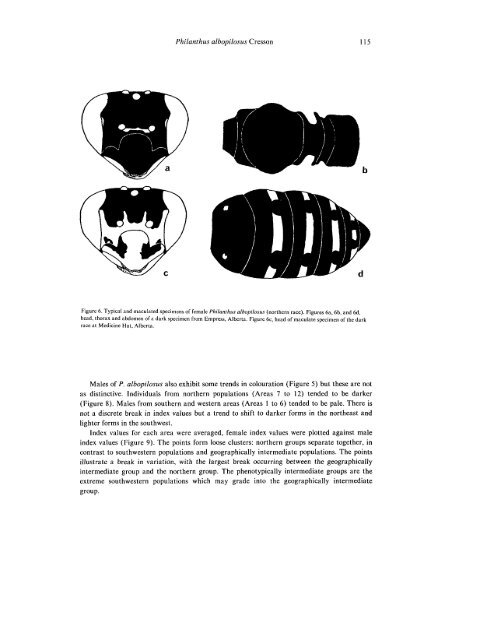Hilchie 1982 QEv18n1_4 91_126 CC released.pdf - College of ...
Hilchie 1982 QEv18n1_4 91_126 CC released.pdf - College of ...
Hilchie 1982 QEv18n1_4 91_126 CC released.pdf - College of ...
Create successful ePaper yourself
Turn your PDF publications into a flip-book with our unique Google optimized e-Paper software.
Philanthus albopilosus Cresson 115<br />
Figure 6. Typical and maculated specimens <strong>of</strong> female Philanthus albopilosus (northern race). Figures 6a, 6b, and 6d,<br />
head, thorax and abdomen <strong>of</strong> a dark specimen from Empress, Alberta. Figure 6c, head <strong>of</strong> maculate specimen <strong>of</strong> the dark<br />
race at Medicine Hat, Alberta.<br />
Males <strong>of</strong> P. albopilosus also exhibit some trends in colouration (Figure 5) but these are not<br />
as distinctive. Individuals from northern populations (Areas 7 to 12) tended to be darker<br />
(Figure 8). Males from southern and western areas (Areas 1 to 6) tended to be pale. There is<br />
not a discrete break in index values but a trend to shift to darker forms in the northeast and<br />
lighter forms in the southwest.<br />
Index values for each area were averaged, female index values were plotted against male<br />
index values (Figure 9). The points form loose clusters: northern groups separate together, in<br />
contrast to southwestern populations and geographically intermediate populations. The points<br />
illustrate a break in variation, with the largest break occurring between the geographically<br />
intermediate group and the northern group. The phenotypically intermediate groups are the<br />
extreme southwestern populations which may grade into the geographically intermediate<br />
group.
















